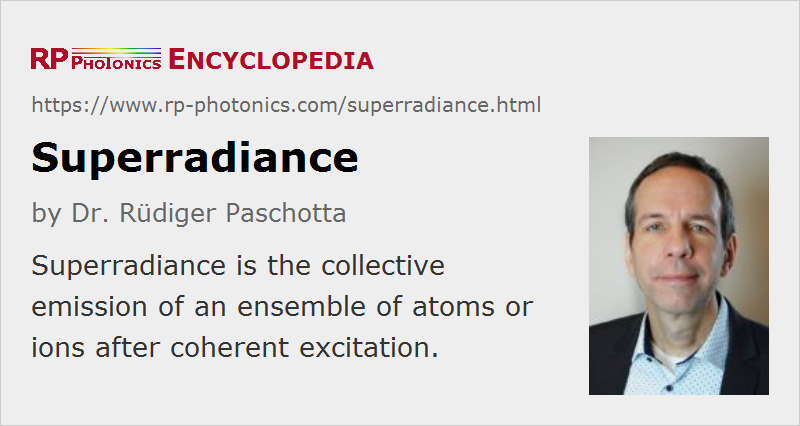Superradiance
Definition: collective emission of an ensemble of atoms or ions after coherent excitation
More general term: luminescence
German: Superradianz
Author: Dr. Rüdiger Paschotta
Cite the article using its DOI: https://doi.org/10.61835/kui
Get citation code: Endnote (RIS) BibTex plain textHTML
Superradiance is a phenomenon of collective emission of an ensemble of excited atoms or ions, first considered by Dicke [1]. It is similar to superfluorescence, but it starts with the coherent excitation of the ensemble, usually with an optical pulse. This coherence (i.e. a well-defined phase relationship between the excitation amplitudes of lower and upper electronic states) leads to a macroscopic dipole moment. The maximum intensity of the emitted light scales with the square of the number of atoms because each atom contributes a certain amount to the emission amplitude, and the intensity is proportional to the square of the amplitude. This demonstrates that the emission of light in a medium is in certain cases not just an intrinsic property of the atoms or molecules of which the medium consists, but rather can be strongly enhanced by a collective behavior of such emitters.
The term superradiance can be understood by considering that it can also lead to very high values of radiance.
As the number of photons rises in a kind of chain reaction, Dicke later (in a patent application) described the phenomenon of superradiance as an optical bomb.
There is the related effect of superabsorption [9], which can be seen as time-reversed superradiance [11].
More to Learn
Encyclopedia articles:
Bibliography
| [1] | R. H. Dicke, “Coherence in spontaneous emission processes”, Phys. Rev. 93 (1), 99 (1954); https://doi.org/10.1103/PhysRev.93.99 |
| [2] | N. E. Rehler and J. H. Eberly, “Superradiance”, Phys. Rev. A 3 (5), 1735 (1971); https://doi.org/10.1103/PhysRevA.3.1735 |
| [3] | R. Bonifacio et al., “Quantum statistical theory of superradiance. I”, Phys. Rev. A 4 (1), 302 (1971); https://doi.org/10.1103/PhysRevA.4.302 |
| [4] | M. Gross and S. Haroche, “Superradiance: An essay on the theory of collective spontaneous emission”, Physics Reports 93 (5), 301 (1982); https://doi.org/10.1016/0370-1573(82)90102-8 |
| [5] | Y. Kaluzny et al., “Observation of self-induced Rabi oscillations in two-level atoms excited inside a resonant cavity: the ringing regime of superradiance”, Phys. Rev. Lett. 51, 1175 (1983); https://doi.org/10.1103/PhysRevLett.51.1175 |
| [6] | M. O. Scully and A. A. Svidzinsky, “The super of superradiance”, Science 325 (5947), 1510 (2009); https://doi.org/10.1126/science.1176695 |
| [7] | Y. D. Chong et al., “Coherent perfect absorbers: time-reversed lasers”, Phys. Rev. Lett. 105, 053901 (2010); https://doi.org/10.1103/PhysRevLett.105.053901 |
| [8] | K. Hammerer, A. S. Sørensen and E. S. Polzik, “Quantum interface between light and atomic ensembles”, Rev. Mod. Phys. 82, 1041 (2010); https://doi.org/10.1103/RevModPhys.82.1041 |
| [9] | K. D. B. Higgins et al., “Superabsorption of light via quantum engineering”, Nature Commun. 5, 4705 (2014); https://doi.org/10.1038/ncomms5705 |
| [10] | M. A. Norcia et al., “Superradiance on the millihertz linewidth strontium clock transition”, Science Advances 2 (10), e1601231 (2016); https://doi.org/10.1126/sciadv.1601231 |
| [11] | D. Yang et al., “Realization of superabsorption by time reversal of superradiance”, Nature Photonics 15, 272 (2021); https://doi.org/10.1038/s41566-021-00770-6 |
Questions and Comments from Users
Here you can submit questions and comments. As far as they get accepted by the author, they will appear above this paragraph together with the author’s answer. The author will decide on acceptance based on certain criteria. Essentially, the issue must be of sufficiently broad interest.
Please do not enter personal data here; we would otherwise delete it soon. (See also our privacy declaration.) If you wish to receive personal feedback or consultancy from the author, please contact him, e.g. via e-mail.
By submitting the information, you give your consent to the potential publication of your inputs on our website according to our rules. (If you later retract your consent, we will delete those inputs.) As your inputs are first reviewed by the author, they may be published with some delay.

 quantum optics
quantum optics
Share this with your friends and colleagues, e.g. via social media:
These sharing buttons are implemented in a privacy-friendly way!